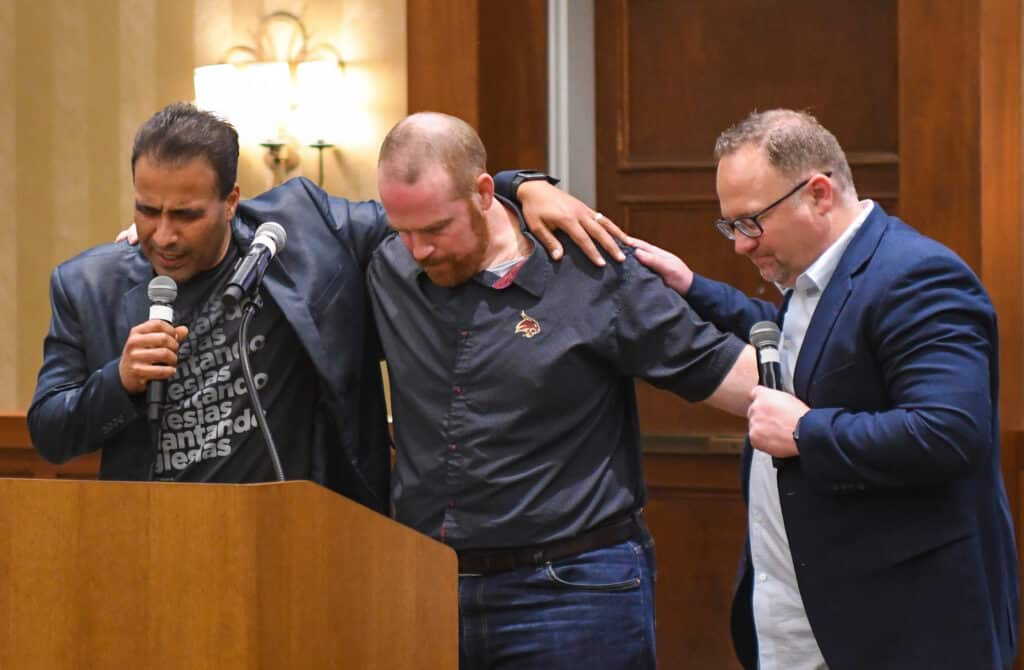Two resources produced by theological educators present a framework for successfully navigating the potential minefield of biblically ordered gender roles in the local church.
Southern Baptist seminary professors Jaye Martin and Terri Stovall teamed up to write “Women Leading Women: The Biblical Model for the Church,” a book purposed to “paint a picture of what women’s ministry should look like based on Scripture.” And from the halls of Dallas Theological Seminary comes “Mixed Ministry: Working Together as Brothers and Sisters in an Oversexed Society,” a book compiled by DTS faculty and alum Sue Edwards and Kelley Mathews urging men and women to view each other as siblings in Christ.
Women Leading Women
Written from a clear complementarian stance, “Women Leading Women” encourages women to serve other women in the local church primarily though women’s ministries. The book offers a framework for approaching women’s ministries grounded in a woman’s identity as an equal image-bearer of God found in Genesis 1 and woman’s helping role found in Genesis 2. The authors trace this helping function through Old and New Testament examples of feminine service to God and family. Their model for women’s ministry concludes with the parameters exemplified in the life and ministry of Christ and explicit Pauline instructions for local church ministry.
And while co-authors Martin and Stovall spend much time outlining the biblical foundations and principles for “women-to-women” ministry, they also offer practical tips for both the woman’s minister serving on a church staff and her pastor.
Martin, director of women’s programs at Southern Baptist Theological Seminary in Louisville, Ky., authored a chapter on serving with men. Having previously served with the North American Mission Board and as a staff member at Houston’s First Baptist Church, Martin said many of the tips she includes in this chapter have proven helpful in her own ministry.
In an interview with the Southern Baptist TEXAN, Martin echoed some of the book’s more practical admonitions to women ministering alongside men.
- Discuss things with other women before you discuss them with men. This helps to get your points to a minimum.
- Speak in bullet points?not in paragraphs.
- Don’t take things personally.
- If they are paying you, then they are supporting you?don’t expect to be affirmed. Realize that decisions are made at the game or during outings. They are not leaving you out intentionally.
- In working with men, leadership is lonely. Find a network of other women to socialize with and to learn from.
- Get to know the families of the men your work with. They need to trust you.
Martin also noted it was important for women to work within the system rather than going around it. “This is a huge problem with women. We tend to do whatever it takes (go around people) to make things happen,” she said. “Most men work within the team structure.” Martin also reminded women to “work as unto the Lord. It is the Lord you are serving.”
Mixed Ministry
Equally based on Scripture, the book “Mixed Ministry: Working Together as Brothers and Sisters in an Oversexed Society” urges men and women to view one another as brothers and sisters in Christ as a means to successful co-ministry. Written by Sue Edwards, DTS assistant professor of Christian education, and Kelley Mathews, DTS alum and women’s ministry leader, the book also includes various contributors such as Christian author Henry J. Rogers and long-time DTS professor and author Howard Hendricks.
Deliberately choosing not to enter into the debate over women’s roles in the church and home, the authors instead center their framework for mixed-gender ministry on Christological and Pauline examples of ministry found in the Gospels and the epistles.
The authors believe that the example of “brotherly love” toward ministry partners found in the New Testament safeguards against sexual temptation and the segregation of any sex from appropriate ministry roles.
“Fear of mixed-gender friendship is understandable in an over-sexed society like ours,” the authors contend. “Women are not veiled; instead they are publicly undressed?also dehumanizing. It’s no wonder Christian men and women put on blinders in an attempt to honor God with pure hearts and minds. But Jesus did not respond to women in fear. He knew that this wall of fear would exclude women from the public square of faith, and it has.”
As a stop-gap to segregating women from ministry positions, the authors plead with believers to follow the example of Christ and Paul and create a “family ethos” by viewing women as sisters in Christ.
“The Bible uses familial imagery to describe ministry relationships,” the authors write, noting Paul’s frequent descriptions of the church as adelphoi (brothers) and his designation of women co-laborers as sisters. “When Paul describes the ethos he created in the Thessalonian church, he paints a picture of a caring family.”
And while the authors concede that the family ethos model of navigating the pitfalls of gendered ministry is more difficult to maintain, several benefits can be gleaned including: physical and emotional protection, help, insight, conflict management, and unity.
This family ethos, the authors contend, begins with the leader and trickles down to co-laborers. To this end, the authors urge leaders to focus on the “one another” passages in Scripture as a means to fostering healthy sibling relationships among ministry partners:
- Be devoted to one another in brotherly love (Romans 12:10)
- Encourage one another and build each other up (1 Thessalonians 5:11)
- Greet one another (Romans 16:16)
- Serve one another in love (Galatians 5:13)
- Accept one another in order to bring praise to God (Romans 15:7)
- Bear with one another in love (Ephesians 4:2).
Edwards and Mathews also provide chapters written for each gender in ministry, combining Scripture’s more generic prescriptions for Christian conduct and gender-specific ways to apply these admonitions. Women in ministry are called to pray for their brothers and their families, develop relationships with the families of their brothers in ministry, refrain from bashing their brothers, and encourage them with appropriate words. Likewise, men in ministry are called to drop demeaning language, value their sisters’ contributions by inviting them into the conversation, and even speak up for their sisters.
“Ethos is invisible?but it can make or break a ministry,” Edwards and Mathews write. “When we do [create a family ethos], we will also create a place where men and women love one another and serve together as brothers and sisters?a radical transformation that just might turn the world upside down for Jesus.”














